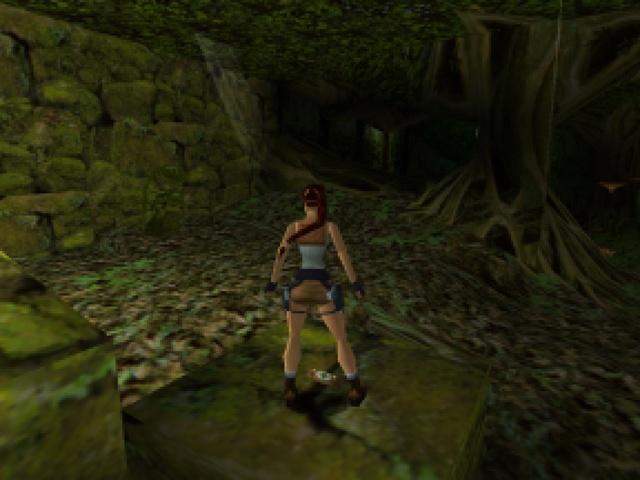Tomb Raider III: Adventures of Lara Croft (PlayStation) Review
By Athanasios  27.10.2016
27.10.2016

The development of the original Tomb Raider pentalogy by Core Design, is a prime example of a producer meddling so much with what its artists had crafted, that it managed to corrupt it completely - something that is almost a tradition in the world of popular culture, be it video games, comics, movies, and even books. This is why, while the mechanics and look of all the PlayStation entries remained largely the same, every title had a surprisingly different feel. Tomb Raider was a simple, yet charming, Indiana-Jones-meets-Prince-of-Persia adventure, whilst Tomb Raider II was grander in scale, but also felt less like an archaeology thriller, and more like an action movie, both gameplay and location-wise. Tomb Raider III: Adventures of Lara Croft, while a tad closer to the original in terms of setting, was a pretty disappointing installment.
With each and every new Tomb Raider game the visuals would be slightly better than how they were before. The improvements over the second title become obvious from the moment the adventure begins. The first romp through an Indian jungle offers a level far more complex in design than any of the stages of the previous instalments, much more detailed, with some great lighting as well as weather effects. Despite the improvements, one could easily say that this isn’t really as good looking. The scene composition of the previous games was much better, with far more iconic moments, whereas this looks good, but forgettable. At least Lara is at her very best, with her animation getting a slight polish, and her wardrobe receiving a small upgrade. The sound has gotten an upgrade, too, with guns that don't sound like firecrackers anymore (Desert Eagle? Auditory orgasm!), and the music, while still shy about making more than two to three appearances per level, is very good.

Where dem infinite saves? Well, it turns out that Core, in a moment of pure genius, went something like, "Hey, why don't we limit saves once more, and make this game the hardest one yet?" Instead of being able to save anywhere anytime like in Tomb Raider II, Lara must collect save crystals, which can then be "consumed" in order to save progress; in essence, the checkpoint system of Tomb Raider returns, but this time the crystals can be collected and used whenever one wants to. In a way this is the perfect way to balance things, as it doesn’t let one spam the save system, but also doesn’t restrict that much regarding the location where a save can be done.
Of course, as mentioned before, this wouldn't be such a big problem if this wasn't so annoyingly hard. Now, challenge in such a title is a good thing and all, but the execution… well, executes it (ha… ha?). There are some minor issues, like the decreased lighting, or the fact that there are many, many narrow spots and corridors, which is weird given the fact that the camera was never the strongest point of the series. But it gets much worse than all that…

The biggest problem is the layouts of the maps. Take everything wrong with past instalments, and double it! Levers that are pulled without the player knowing what happened? Backtracking? Stages that overstay their welcome by 20 minutes? Hard to “read” platforming sessions that lead to certain death? These are all here. Even worse is the increase in trial-and-error focused gameplay, which was already the biggest flaw of the sequel. Simply put, there are many occasions where it is impossible to know what needs to be done before dying at least once, and even then some moments can be more annoying than fun. It doesn’t help that you can easily die just by exploring around, as levels are filled with instant death traps of all kinds. There are stages where you barely have room to walk around in order to check the surroundings.

Even the plot seems to have slightly jumped the shark, but not because of the premise, since this is actually very… Tomb Raider! The problem lies, once again, in the way it's all handled. Lara must collect a bunch of meteor pieces for various places around the world, but the dialogue sequences in the cut-scenes include some irritatingly heavy accents and badly recorded voice acting that makes it hard to follow what's going on, and what's going on isn't worth following, anyway. There’s some genuine tomb raiding to be done here, sure, but the rushed production is obvious from the very beginning.
Generally, like with the sequel, the overall presentation lacks the mystery and awe of the original. Instead of long lost ancient civilisations, here's a guy that wants to become Magneto and mutate everyone on earth; instead of Atlantis, take a look at a cave underneath Antarctica, or even worse, a military complex; instead of an Indiana Jones-like epic, enjoy a generic action flick with a top-heavy protagonist… good in most chaps' book, but not that good for a long ride through pain and suffering.

Cubed3 Rating
Average
After its enormous initial success, Eidos tried to milk its cow, and the result of this always-bad business practice led to a game that looks like Tomb Raider but isn't one. Tomb Raider III: Adventures of Lara Croft has temples to explore, obstacles to overcome, trinkets to find, and things to shoot at, but it all is annoying and tiresome instead of riveting.
Comments
Comments are currently disabled

 Sign In
Sign In Game Details
Game Details
 Out now
Out now  Out now
Out now  Out now
Out now  Out now
Out now  Subscribe to this topic
Subscribe to this topic Features
Features






 Top
Top

